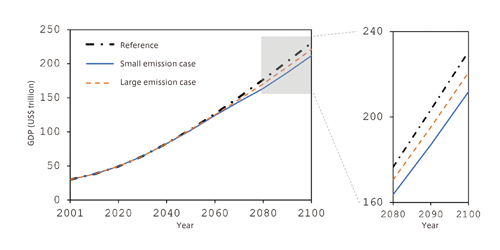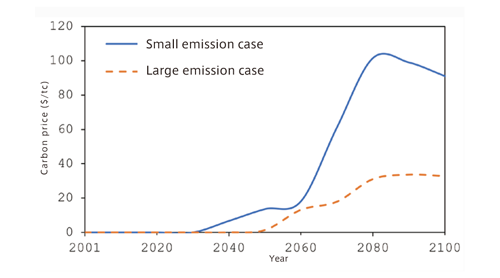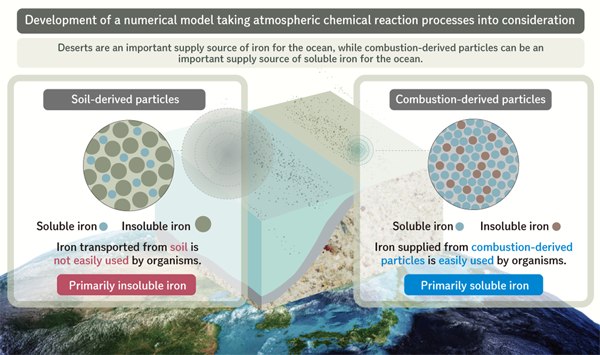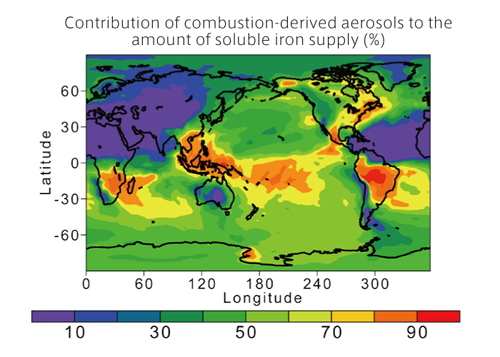Theme B: Climate change projection contributing to stabilization target setting


| Representative: Michio Kawamiya Director, Project Team for Risk Information on Climate Change, JAMSTEC |
How much impact will the reduction of anthropogenic CO2 emissions have on the global climate? In handling such a question, we also need to take biological and chemical processes such as photosynthesis of plants into consideration. In this theme, we study global climate issues, using an" Earth system model" which is a climate model incorporating biogeochemical and chemical processes.
 Impact of the uncertainty of the Earth system model on social and economic projections
Impact of the uncertainty of the Earth system model on social and economic projections The amount of carbon that human beings may emit in the future cannot be determined automatically even if we set a target for the degree of global warming control. The amount varies depending on the amount of carbon absorbed by land ecosystems and the ocean. To develop a global warming control scenario for the future, it is important to consider the impact of the uncertainty, which is caused by such models' differences in the responses of the Earth system components, on socioeconomic systems.
This research emphasizes a combination of climate and economic models to study this point. Specifically, we have conducted the following studies.
First, as the preconditions of the research, we adopted the intermediate stabilization scenario(RCP4.5) which is the second lowest temperature rise among the four Representative Concentration Pathways* used in the IPCC's Fifth Assessment Report. In the scenario, we took note of the amount of carbon that can be emitted to realize annual target concentrations, analyzed the impact of the uncertainty of the "Earth system model," which is a climate model capable of considering the absorption of greenhouse gases, on society and the economy, using an "applied general equilibrium model" which is one of economic models, and we obtained the following results.
(1) When the world's total GDP without global warming countermeasures is set at 100, the world's total GDP in 2100 will be 95.8 if the amount of carbon that can be emitted is large, while the GDP will be 91.9 if the carbon amount is small. (The difference in the carbon amount is attributed to the uncertainty of Earth system responses.) GDP in the case of a small amount of emitted carbon is lower by 4.1% than GDP in the case of a large amount of carbon (Fig. 1).
(2) There will be a difference of three times in the carbon price (carbon tax), depending on the difference in Earth system responses, between the small and large emission reduction cases, even if the target CO2 concentration is the same (Fig. 2). Thus, the difference in Earth system responses has a significant impact on emission reduction scenarios.
(3) The estimated total demand for primary energy in 2100 does not differ greatly between the smallest and the largest emission cases. However, the demand structure in two cases differs. In the largest emission case, the use of fossil fuels is relatively large. In particular, natural gas is expected to be used in the largest proportion. In the smallest emission case, on the other hand, the use of fossil fuels is relatively suppressed. Instead, the use of renewable energy will increase. In particular, the proportion of biomass is expected to be the largest.

The figure on the right is an enlarged 2080-2100 graph. (Matsumoto et al. 2015, Computers & Operations Research)
These results suggest that the amount of carbon that can be emitted has more than a little impact on the economy but that the difference in the amount will not generate a significant difference in economic growth if a single carbon price is applied by such means as worldwide emission trading and if the reduction of emission is realized efficiently.
* Scenarios that present the future changes in the concentration of atmospheric
greenhouse gases causing global warming, also known as RCPs.

 Learning from the Earth and thinking over geoengineering approaches
Learning from the Earth and thinking over geoengineering approachesIron dissolved in the seawater is an essential nutrient for phytoplankton and is indispensable for photosynthesis. In other words, iron is an important element when we think of how much marine ecosystems absorb CO2 and reduce global warming. Iron is supplied to the ocean from the atmosphere via aerosol.* Iron solubility, which indicates the degree of availability of total iron in aerosol for organisms, is observed in a wide range from 0.01% to 80%. Numerical models incorporating an iron cycle in the ocean assume that a certain proportion of soluble iron exists in soil-derived aerosol particles. This makes the calculation of the amount of CO2 absorption by marine ecosystems highly uncertain.

The "global aerosol chemical transport model" developed in this research simulates from where aerosols are supplied and how aerosols circulate around the Earth. The model dynamically solves the aging process in which relatively insoluble iron in fine particles originating in forest fires and fossil fuel combustion, in addition to soilderived aerosols, chemically reacts with inorganic/organic acidic substances and dissolves out. This is the first numerical model that is capable of reproducing a wide range of measurements (i.e., 1 to 2 orders of magnitude lower iron solubility in mineral dust
aerosols than in combustion-influenced aerosols). Simulation results revealed that the high iron solubility observed in aerosols is related primarily to combustion-derived aerosols, suggesting the importance of fossil fuel combustion as the supply source of soluble iron.
Spraying soluble iron in the ocean is proposed as a geoengineering method to promote the
photosynthesis of phytoplankton and to remove CO2 from the atmosphere. The results of this
research suggest that soluble iron has already been dumped in the ocean through human activities, although it was not an intentional activity.
* Liquid or solid micro-particles floating in the air

the IMPACT global aerosol chemical transport model (Ito 2015, Environmental Science & Technology Letters)
 Aims of Theme B " Climate change projection contributing to stabilization target setting"
Aims of Theme B " Climate change projection contributing to stabilization target setting"To control global warming and to avoid violent environmental changes, it is necessary to develop well-established future scenarios for the reduction of CO2 and other greenhouse gas emissions, taking socioeconomic aspects into consideration. To develop such scenarios, we must not only comprehend how CO2 circulates in the global environment (carbon cycle) but also pay attention to the possibility of some irreversible, rapid changes, such as ice sheet collapse, if CO2 emissions are not regulated. We should also understand whether or not the artificial control of climates, including iron spray in the ocean, is effective, along with the side effects of such control, in order to avoid rapid changes. In this theme, we will contribute to the development of ways to control global warming through efforts to resolve these complex issues.

